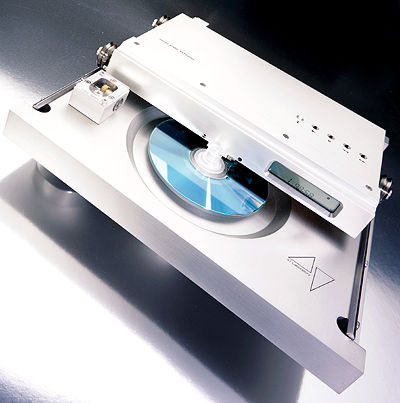| Columns Retired Columns & Blogs |
47 Laboratory 4704 PiTracer CD transport
Every once in a while, a piece of super-esoteric gear crosses my path that, on the face of it, makes no sense whatsoever. Eventually, however, the component is revealed as being "merely" simple and elegant, begging the question: Must it always be done the way it's always been done?
The 47 Labs 4704 PiTracer CD transport is such a product. The French, who I think are close in some ways to the Japanese in their design aesthetic, would certainly call the PiTracer une grande follie. Anyone might be forgiven for thinking so—the PiTracer is bizarre at first glance.

But the logic behind the PiTracer is impeccable. What's called for, after all, is to rotate a CD at a constantly diminishing speed as the lens tracks from the inside to the outside of the information-carrying layer, while keeping the laser focused on the pit spiral burned in the polycarbonate so that the ones and zeros are faithfully retrieved. The PiTracer does precisely that, and in a most original and unusual way.
Pedigree
The PiTracer, we are told, is the result of twelve years of R&D by one Mr. Junji Kimura. According to the Sakura Systems website, "This machine is the reason he established 47 Laboratory in 1992." The web article goes on to speak of Kimura's journey so far, which includes his Gaincard amplifier (to be reviewed by Robert Deutsch in our December 2001 issue), Flatfish CD transport, and other products. You can also read of his unending audio quest: "at the core of his creative activity was the PiTracer."
According to Yoshi Sakura of US importer Sakura Systems, everyone waited with bated breath for Mr. Kimura's nod on the PiTracer, while several prototypes were made and rejected. "But now, the dream machine is finally here!"
Let's take a gander...
The PiTracer is built on the Platform, a base plinth almost the size of an LP, if rather deeper, and machined from solid aluminum. Dominating the front section is the nice-looking, solid-acrylic CD turntable with its lightweight, translucent, screw-down clamp. Each of the PiTracer's rear corners has a skinny aluminum footer to provide a stable base.
The Platform supports the spindle motor and contacts the shelf below with a mechanical ground that tapers to a point. It's the audiophile equivalent of Falling Water, that wonderful home designed by Frank Lloyd Wright and built over a Pennsylvania waterfall.
If you grunt and bend to peer beneath the Platform, you'll see another motor housing to the left, close to the front, also coupled to the stand by a point. Its spindle pops up through the Platform and connects to the laser sled via a worm gear—the motor head/worm gear assembly is visible through a clear-topped aluminum casing. You can see, all too graphically, the motor correcting like mad for off-center CDs. In fact, it's amazing just how much off-center most CDs are, which is why the CD system is built around heavy feedback servo systems to deal with the problem.
Like a spaceship from 2001 looming over the platform—I can almost see the astronauts in the control room—not just the laser pickup but the entire sled makes its way from a CD's beginning, or inner "groove," and tracks back out to the end of the pit spiral, at the outside edge of the polycarbonate disc.
The sled is carried on two wheels on the left side (looking from the front) and a single wheel on the right, running on stainless-steel knife-edge rails and deeply grooved wheels. (Curiously, the rails are made in America, their manufacturer's name and location stamped proudly upon them: Bishop-Wisecarver, Pittsburgh, California!)
The heart of the transport is the intricately wound and spring-loaded Thread Drive Mechanism, which controls the actual back-and-forth movements of the sled. The thread has a Kevlar core and a polyethylene jacket, and winds its way from the worm-gear drive up front via a bearing to a small locating stud on the lower front vertical edge of the sled behind the front wheel, then runs past the rear wheel all the way back to the rear of the platform, U-turns there on an aluminum post/bearing, and heads back for the sled. There it wraps around another locator stud, rises up and over the rear wheel to another stud/locator, then runs forward about half the distance of the sled, at which point the thread is tied to a small, high-tension spring that's attached to the sled.
Importer Sakura explained that, via the worm gear linked to the drive motor, the motor moves the sled with a minimum of servo assist from the laser assembly. The information regarding the off-centeredness of any particular CD is fed to the servo, which in turn adjusts the movement of the motor, thus the sled—not just the laser pickup, as is usually the case. Thus, the angling movements required of a typical laser assembly are minimized, and the laser is always at a healthy 90 degrees angle to the pit information. Neat.
The two motors themselves are anything but pedestrian. They're direct-drive, "with a highly sensitive, low-inertia, high-torque coreless motor with a spindle diameter of 3mm." The spindle and sled motors are driven by four op-amps of the same grade found in 47 Lab's 4706 Gaincard amp, and control. "With the combination of this simple mechanism, we have realized smooth and quick analog management." Interesting way to put it.
- Log in or register to post comments



































